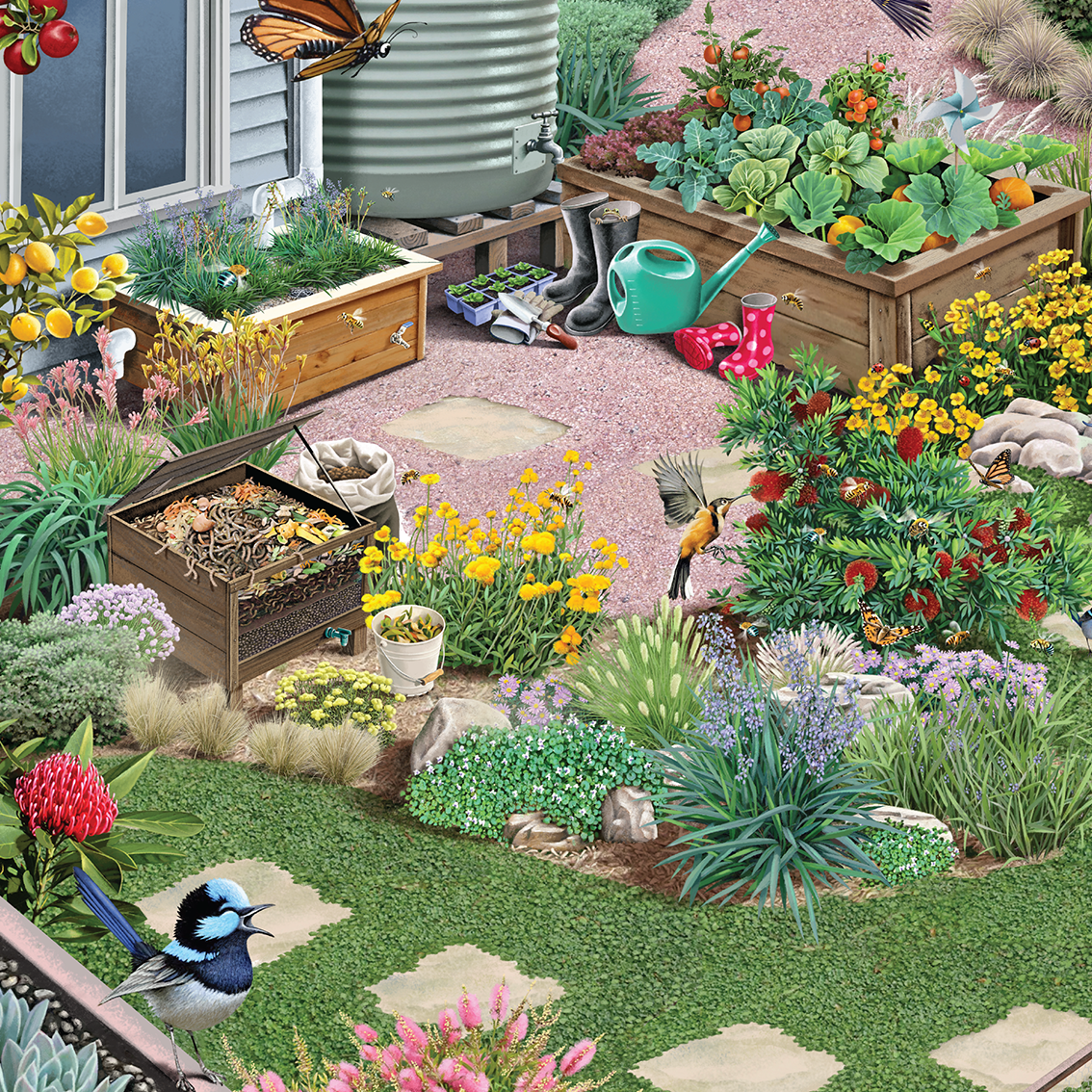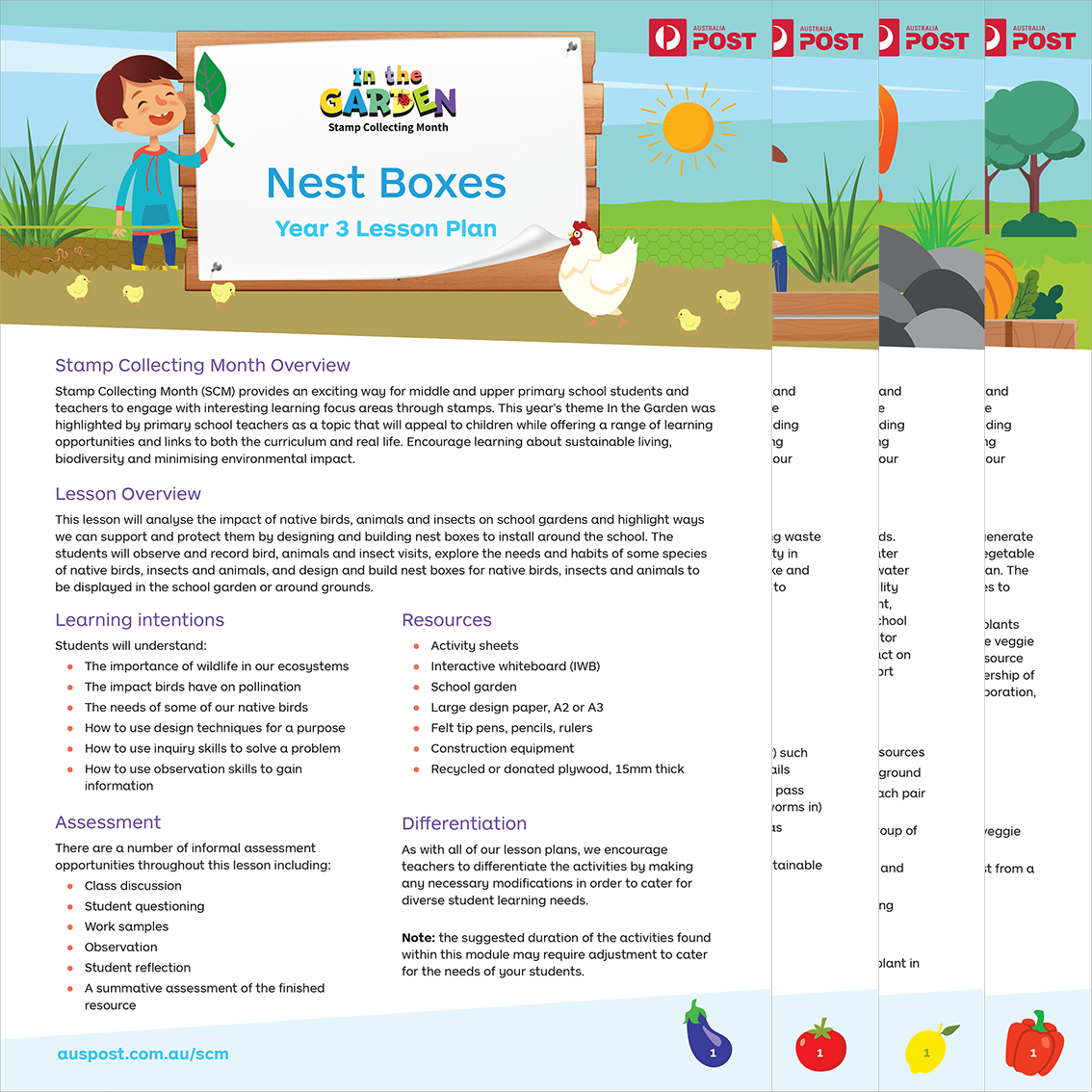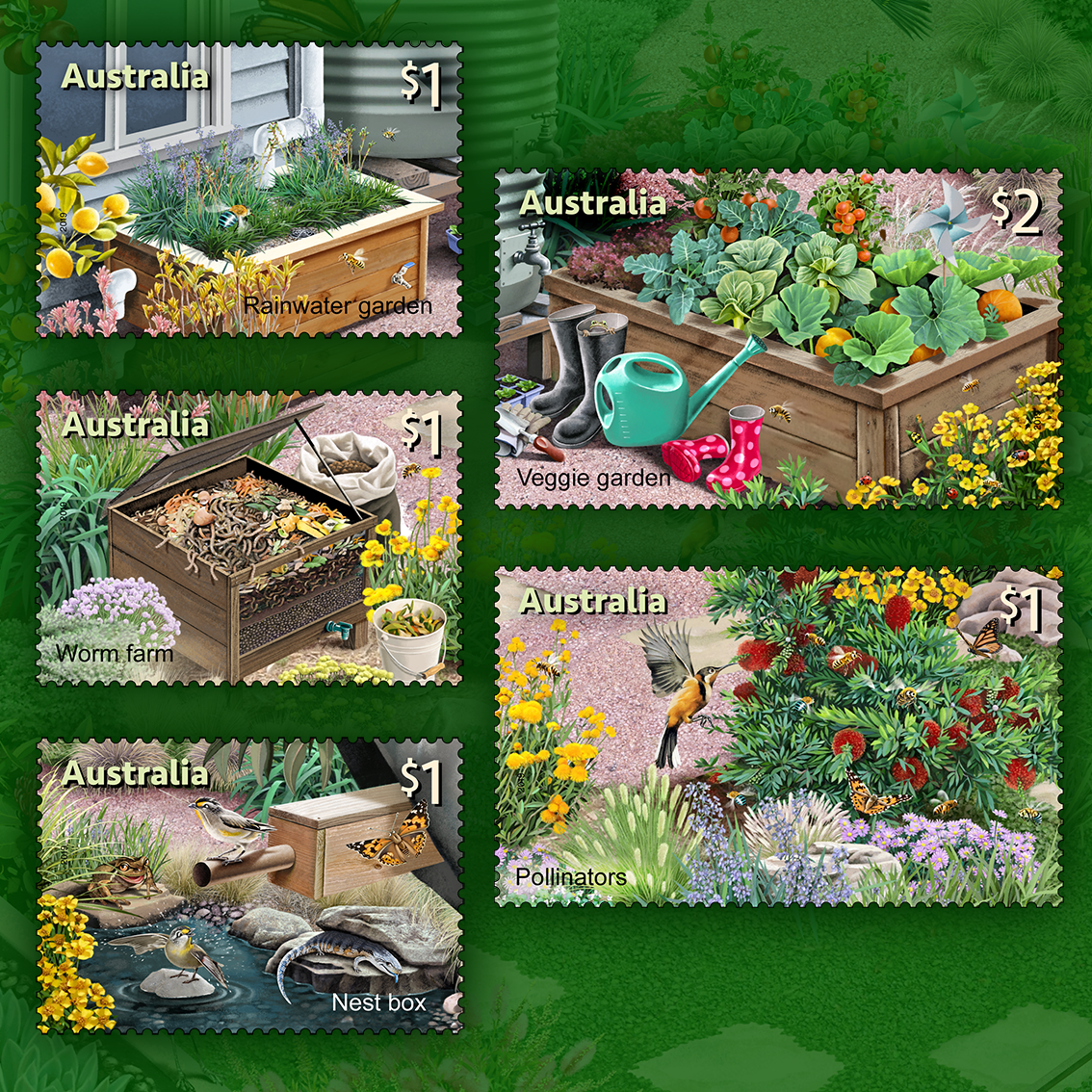
In the Garden stamps

Rainwater garden
A rainwater garden, as its name suggests, makes use of rainwater but also benefits the health of surrounding waterways. It is a specially designed and constructed garden bed that takes rainwater directly from the roof – the downpipe goes straight into it and overflow is directed into the stormwater system. A filtering mechanism is used to remove pollutants, which is how it assists with waterway health.
Our rainwater garden is made from recycled materials, with a layer of sand and gravel at the bottom. It houses Dianella caerulea and Green Kangaroo Paw (Anigozanthos viridis), with pebbles surrounding the plants to retain soil moisture. Buzzing around the Dianella is a Blue-Banded Bee (Amegilla cingulata), a native bee that carries out “buzz pollination”. Buzz pollination is a technique that allows certain species of bees to release pollen from flowers with tubed-shaped anthers by gripping the flower and causing vibrations with their rapid wing movement. Honey bees can’t perform this type of pollination.

Veggie garden
Our veggie garden is housed in a raised, contained garden bed, which is a great way to grow pesticide-free vegetables all year round – no digging up the ground, no trampling through and squashing the soil and no extreme bending when tending to the garden. A raised bed also makes it harder for household pets and pests to enter.
The raised bed is made from recycled materials and contains around 40 centimetres of very good-quality soil. We’ve planted quite thickly too (allowing room for our plants to grow, however) and we’ve covered any space with mulch. We’ve placed the bed in a sunny part of the garden – away from the shade of our large gum tree. At various times of the year, we grow a variety of vegetables to eat, including tomatoes, lettuce, cucumber, pumpkin, broccoli and broad beans. There’s a companion flowering plant, too – a marigold that attracts bees for pollination and pest-eating ladybirds such as the Common Spotted Ladybird (Harmonia conformis) and Fungus-eating Ladybird (Illeis galbula).
We water our veggie garden from our rainwater tank, make mulch from garden waste and fertilise with the nutrient-rich fertiliser from our worm farm! Traditional scarecrows aren’t the best choice for a sustainable garden, as they can scare away the smaller birds that we want to attract and keep. Instead, we have a small wooden windmill discouraging garden creatures from eating our veggie crops.

Nest box
One way of attracting and protecting the small birds in our garden is by constructing a nest box. This allows the birds (and other wildlife, too) to live, breed and shelter in a protected environment.
The Striated Pardalote (Pardalotus striatus) is a small (nine to 10 centimetres long) and brightly coloured insect-eating bird, found only in Australia. While there is a fair amount of colour variation in this species, all have white eyebrows and a yellow spot in front of the eye, greenish-grey colouring on the back and a white stripe on the wing. They enjoy living in gum trees, feeding in the leaves in the tree tops, though also sometimes in low shrubs. They help to keep down pest insects in our garden. A pond gives this and other bird species somewhere to bathe and drink, as do bird baths.
The nest box for the Striated Pardalote is smaller in height and longer in depth than the typical upright variety. The bird builds its nest inside and it includes a small perch at the front.

Worm farm
While worms are vital to soil health, the wonderful work of worms can also be harnessed as a form of composting to produce nutritious fertiliser for the garden.
We have recycled some non-treated timber from pallets to make a box to house the farm, but old polystyrene foam fruit boxes are also appropriate because they are non-toxic and offer good insulation. The worm farm has three layers: a layer for food waste and leaf litter, a layer for the worms to digest and sleep, and a layer to collect the worm “juice”, which becomes the concentrated liquid fertiliser that is so beneficial to the garden. The worm castings can also be used as slow-release fertiliser.
The species of worms in our worm farm include the Tiger Worm (Eisenia fetida) and Blue Worm (Perionyx excavatus). We regularly feed the worm farm with our well-chopped food scraps, being careful not to include citrus scraps, bread, meat, garlic or onions. The worms also like to eat old mulch, small soft garden prunings and even shredded newspaper.

Pollinators
Pollination is a vital process. While some crops such as cereals are wind-pollinated, many crops that we eat (fruits, vegetables and nuts) require animal-assisted pollination to grow and reproduce, as do many native plants. In our garden, birds, butterflies and bees move pollen from the male structures of a plant (“anthers”) to the female structures (“stigma”). This results in fertilisation, which in turn allows the flower to produce seeds and bear fruit, and causes new plants to grow.
In our garden, we can see an Eastern Spinebill (Acanthorhynchus tenuirostris), a honey-eater found in south-eastern Australia that feeds on the nectar of Bottlebrush flowers. It hovers like a hummingbird as it feeds, extracting nectar from the tubular flowers with its very long and thin curved beak. It has white outer tail feathers, with white on the breast, and white with patches of reddish-brown (rufous) on the throat. Its wings and lower back are dark grey and the underparts and upper back are a tan colour. The pinkish-purple Brachyscome daisies in our garden not only help to prevent weed growth, but they also attract pollinators such as honey bees, butterflies and native bees, as does the bright-yellow Clustered Everlasting Daisy.
While the pollinating animals search for nectar to eat, they collect pollen on their legs and/or body in the process, or in the case of buzz pollination carried out by some native bee species, the pollen is shaken free and spread around. Feeding on nectar and pollen also provides beneficial nutrients for the pollinators, including carbohydrates, proteins, fats, vitamins, minerals and phytochemicals.
Explore the In the Garden Stamp Collecting Month website
-

-

Lesson plans
-

In the Garden stamps
Browse our Stamp Collecting Month themes from previous years
-

Aussie Big Things - Stamp Collecting Month 2023
-

Australian Dinosaurs - Stamp Collecting Month 2022
-

Full STEAM Ahead! – Stamp Collecting Month 2021
-

Wildlife Recovery – Stamp Collecting Month 2020
-

In the Garden – Stamp Collecting Month 2019
-

Reef Safari – Stamp Collecting Month 2018
-

Dragonflies – Stamp Collecting Month 2017
-

Endangered Wildlife – Stamp Collecting Month 2016
-

Our Solar System – Stamp Collecting Month 2015
-

Things That Sting – Stamp Collecting Month 2014




